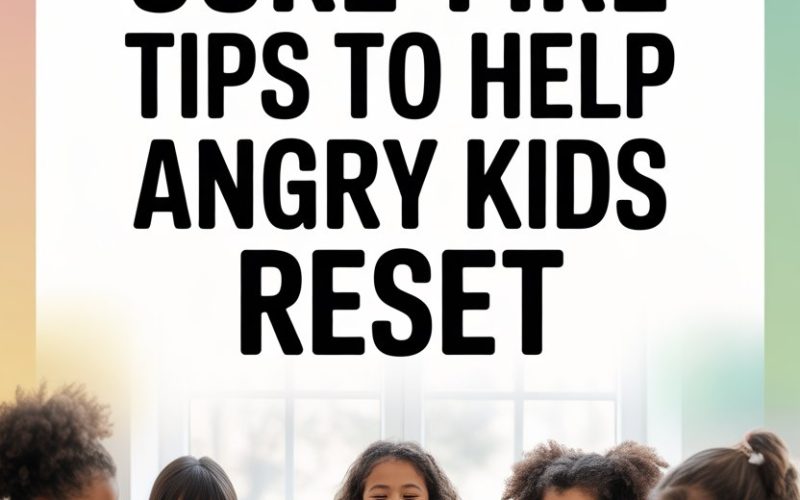Ever tried to reason with a furious six-year-old? It’s a bit like negotiating with a tornado.
One minute you’re baking biscuits, the next your living room looks like a scene from a disaster movie (and you’re wondering if you’ll ever see your remote control again).
Anger is a normal part of childhood, but when frustration takes over, every parent wants to help their child find their way back to calm. Good news: you don’t need to be Supernanny or have a psychology degree.
These tried-and-true tips are designed for real, busy families—yes, even on the days when you’ve only had three hours of sleep and the cat’s just knocked over your last cup of tea.
1. Get Down on Their Level
Nothing says “I’m listening” quite like crouching down and making eye contact. Kids who feel heard are less likely to escalate. Forget the looming adult act; a squat or gentle sit beside your child is a simple way to show you care.
According to child development experts, this non-threatening posture communicates respect and helps children feel safe enough to open up. Source
2. Name the Feeling
“Looks like you’re feeling really mad right now.” Labeling feelings takes away some of their power and gives your child the language to express what’s going on inside.
Little ones aren’t born with an emotional dictionary, but you can help them build one word at a time.
3. Breathe Like Dragons
Deep breathing can sound dull—unless you call it dragon breathing. Invite your child to “blow out fire” slowly through their mouth. Not only does this ramp up the fun, but it also sneaks in relaxation.
Studies suggest that controlled breathing can help calm the nervous system. Source
4. Offer a Safe Space
Some kids need a break from the action. Set up a cozy corner with soft pillows, a stuffed buddy, maybe even a weighted blanket. (No, it’s not a punishment hideout. Think of it as the “VIP lounge” for big feelings.) When you steer your child to this spot, you’re showing that their emotions aren’t too big for you to handle.
5. Keep Your Cool (Fake It if You Must)
Children are emotional sponges, soaking up your mood. When your child goes volcano-mode, staying calm can make all the difference.
If you’re about to lose it yourself, take a “mum timeout”—even if it means locking yourself in the loo for thirty seconds. You’re modeling self-control and teaching that feelings don’t have to run the show.
6. Move Those Muscles
Physical activity is a game-changer. Suggest a race to the letterbox, star jumps in the kitchen, or a quick walk around the garden.
Movement helps burn off the angry energy and floods the brain with feel-good hormones. There’s a reason play therapists keep trampolines and balance boards on standby.
7. Use the Power of Water
Splashing hands in cold water or sipping from a chilled water bottle can short-circuit a meltdown. There’s actual science behind this: cool sensations help reset the nervous system. Source
It’s like pressing the refresh button—no tech required.
8. Encourage Artistic Outbursts
Hand your child crayons, markers, or even a pile of scrap paper and let them “draw the angry.” Art is a safe way to express big feelings without words.
Some kids might scribble furiously, others could paint a red volcano. It’s all valid (and hey, it’s cheaper than therapy).
9. Offer Choices (Small Ones Will Do)
Power struggles feed anger. Whenever possible, hand back a bit of control: “Want to wear your blue hat or your stripy one?” “Would you like apple slices or carrot sticks for snack?” These tiny decisions help your child feel less trapped and more heard.
10. Use a Calm-Down Toolkit
A shoebox with fidget toys, stress balls, sensory bottles, or even a favorite book can be a lifesaver. Keep it somewhere easy to grab. When tempers flare, offer the toolkit as their secret weapon against anger.
Many therapists recommend sensory objects as grounding tools for big emotions. Source
11. Tell a Silly Story
Sometimes, that grumpy face melts with a quick change of topic. Make up a ridiculous story involving your child’s favorite animal doing something bonkers (“And then the dinosaur put on your pajamas and danced the cha-cha in our kitchen!”).
Humor can break the cycle of anger and bring everyone back to the land of giggles.
12. Set Clear, Predictable Boundaries
Wobbly rules are a recipe for frustration. Calmly remind your child of the boundaries—even mid-tantrum. “It’s okay to be mad, but it’s not okay to throw blocks.” Keep it short and non-negotiable.
Consistency helps kids feel safe—even when they’re testing every limit you’ve ever set (and a few you haven’t).
13. Give a Gentle Physical Anchor
A hug, a rub on the back, or even a firm squeeze on the hand grounds your child in the moment. Not every kid wants contact when they’re upset, so always ask: “Would you like a cuddle or some space?”
Studies show that supportive physical touch can lower stress hormones in children. Source
14. Debrief When the Storm Passes
After the outburst, circle back for a low-key chat. “Wow, that was a big feeling. What helped you feel better?” This is when kids can learn from the experience without shame.
You’re not holding a court session—just connecting over a cuppa (or juice box), making it clear everyone survives tough moments.
15. Model Your Own Resets
No parent is zen all the time (anyone who claims otherwise is definitely fibbing or has an army of nannies). When you’re frazzled, narrate your strategy: “I’m getting cranky, so I’m going to take some deep breaths.”
When your child sees you using these tips, you become their best teacher. Monkey see, monkey do.
When Angry Moments Are Just Part of the Job
Kids aren’t born with a user manual or a magical reset button. Big feelings—especially anger—are part of growing up, even if it means your favorite mug occasionally bites the dust.
With patience, creativity, and a few tricks up your sleeve, you can guide your child ::contentReference[oaicite:5]{index=5}





